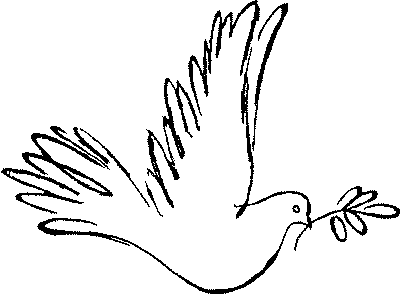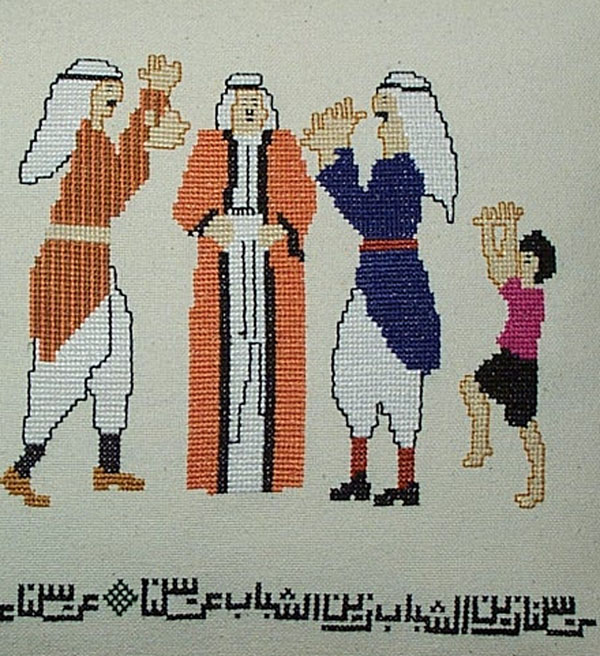 |
|
 |
Palestinian Wedding
This embroidered piece is titled The 'Palestinian Wedding' which was purchased while we were visiting Ramallah. The picture depicts a typical Palestinian country wedding with its rituals, the dabkeh folk dance, the bride on a horse, and the traditional "mansaf dish". Individual sections of the picture were enlarged and are shown below.

The first scene to the farthest right of the main picture shows a boy and a group of men doing al-zaffeh. Here, friends and family of the bride and groom clap and chant various phrases which praise the bride and groom and their qualities, talk directly to the groom telling him how lucky he is to be wedding 'this' bride and talk directly to the bride telling her how happy she will be with this groom. It is a chant because the men repeat the few phrases in their song over and over. At some point, those participating in al-zaffeh sing in two groups where one group sings a phrase and the other answers by repeating the phrase or starts a new phrase. The writings under the scene are those of the words chanted.
The first stanza of the chant "Areesna zein el-shabab, zein el-shabab areesna.", translates into "Our bridegroom is the best of youth, the best of youth is our bridegroom". The second stanza of the chant "Areesna 'Antar 'Abs, 'Antar 'Abs Areesna" translates into "Our bridegroom is 'Antar 'Abs, 'Antar 'Abs is our bridegroom." 'Antar 'Abs is the tribal hero of Arab folklore love story, who falls madly in love with his maiden Leila and saves her from the brink of disaster when she is kidnapped from her desert tent palace by a raiding enemy party. The third stanza of the chant translates into "The sun which is in the sky, know that we have a bridegroom on our earth today". The fourth stanza translates into "Our bridegroom is the sun of the dawn, he asked the bride's hand and wasn't shy."

The traditional Zaffeh
The second scene in "Palestinian Wedding" is that of the traditional mansaf which is the food traditionally served during all large gatherings in Palestine, especially weddings. The mansaf consists of steamed rice over large paper-thin circular 'shraak' bread served in large(36" diameter) deep wooden plates topped with chunks of roasted lamb, or a whole quarter of a lamb (or goat in certain areas), moistened with cooked goat yogurt. The plates are placed on white sheets spread on the ground with the guests seated on the ground in groups of four to eight, each group sitting in a circle around a plate. Guests eat with one hand only, their right hand, scooping the rice and the meat directly with their hand and shaping the rice into a golf ball, but only from the section directly in front of them. Guests who are more fortunate to have more loot in the section directly in front of them, or have easier access to the lamb, usually cut and throw pieces of lamb in front of the other guests. This arrangement and ingredients of Palestinian mansaf are fairly typical in most Arab countries. Many of our American friends who worked with us in Saudi Arabia fondly referred to the traditional mansaf there as "goatgrab".

The Traditional Mansaf
The third scene in "Palestinian Wedding" depicts the coming of the bride on a horse. Palestinian country weddings are normally segregated by sex. Men usually gather in one group with the bridegroom, and women gather separately in another section. Women sing their own songs in which they mainly praise the bride for wanting to take care of her bridegroom and her future family. They 'ululate', making a sharp loud but pleasant sound, then immediately utter the praise, and best wishes, for the bride and her family and the groom and his family. Most of the wedding ceremonies keep the bride away from the groom until she, toward the end of the ceremony, enters the ceremony on a horse, seated sideways and dressed in full traditional Palestinian clothes with the head dress, al-suffeh, lined with gold coins all around her head. At this time, the ululations, zaghareet, intensify and increase in frequency, an indication (or as if to announce) that the bride has arrived.

The coming of the bride on a horse
The last scene in "Palestinian Wedding" is that of the dabkeh, the typical Arab folk dance. The dabkeh is practiced in most Arab countries with some variations from country to the other.

The dabkeh Arab folk dance
ZAGHAREET
Al-sahjeh and al-dabkeh are two forms of expressing joy at a wedding. Another form which is practiced by women is "Zaghareet" which means "ululations", the cries of joy that Arab women make during weddings and other happy occasions. Zaghroutah, the singular of Zaghareet, is a sharp and crisp sound, which expresses loudly (very loudly) a happy wish for an individual or groups. In addition, each region in Palestine has its own zaghroutah.
© 2000 Prepared by HBL - All Rights Reserved
